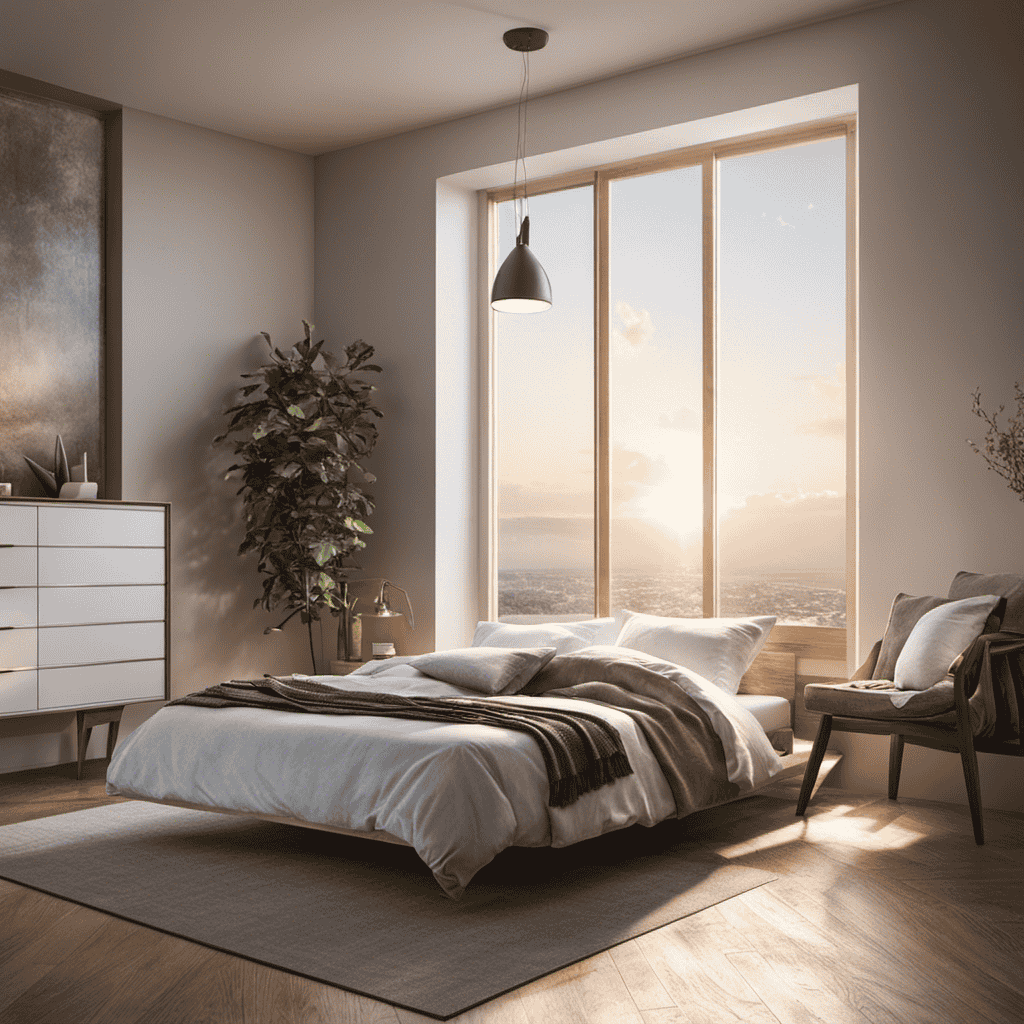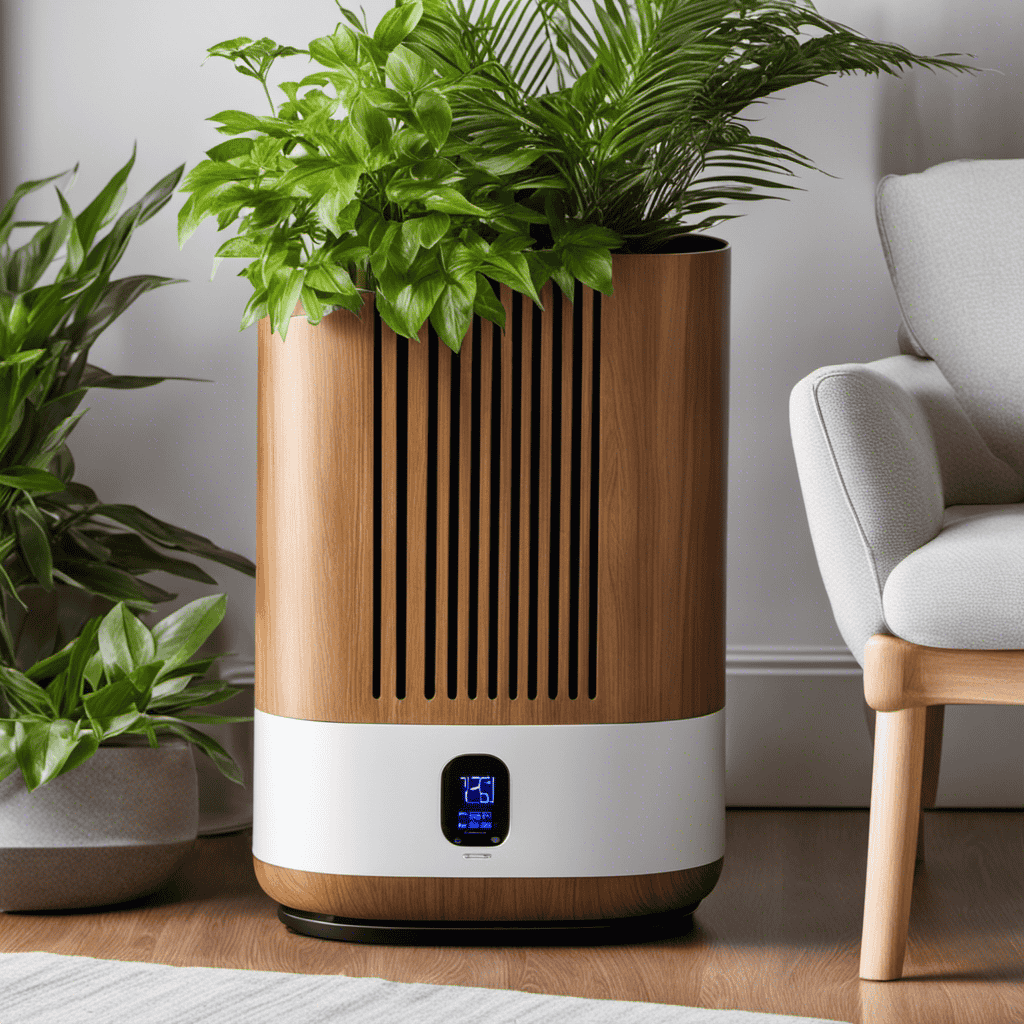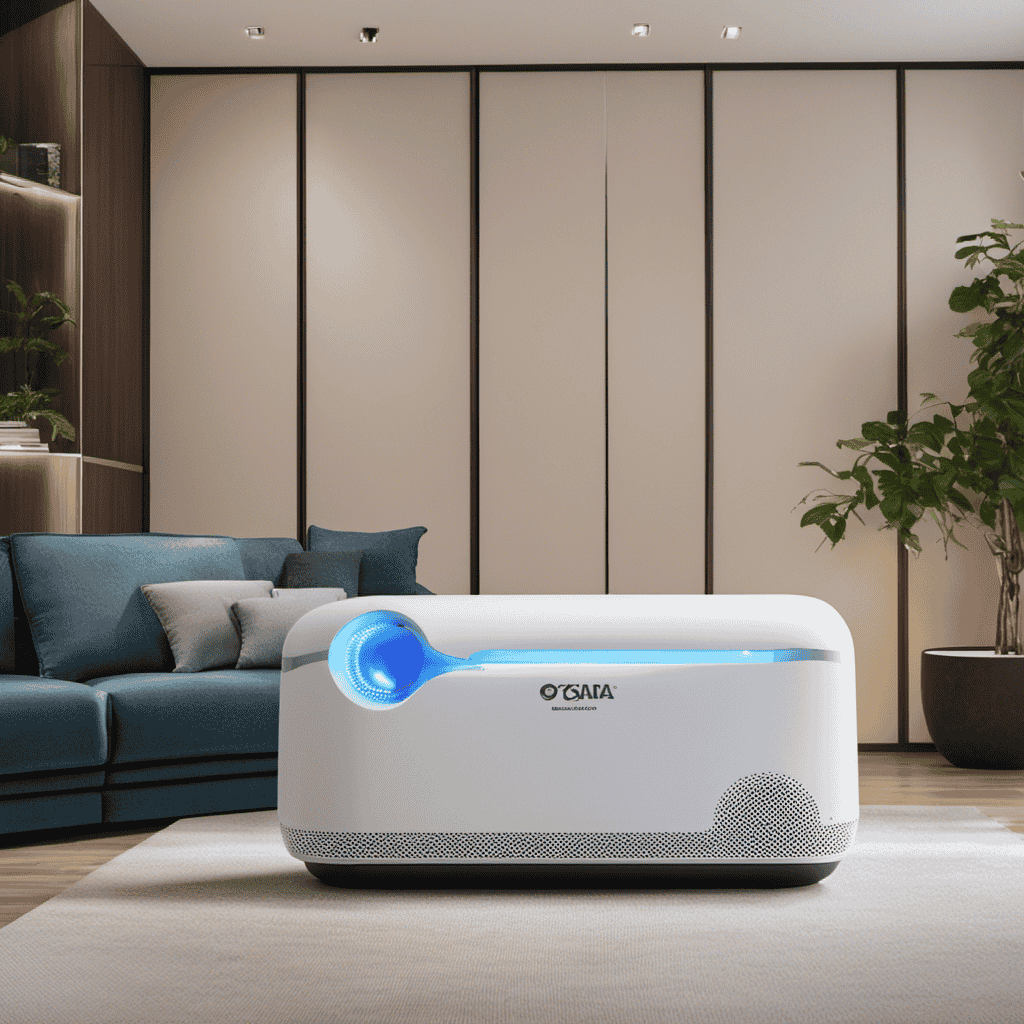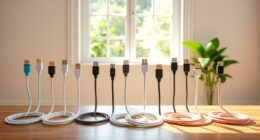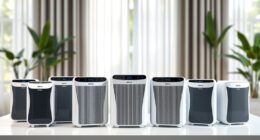I’ve always been curious – how frequently should I be using an air purifier? This is a common query that many individuals have, especially with worries regarding indoor air quality becoming more prevalent.
Well, in this article, we’ll dive into the research and provide you with all the facts you need to know. From the benefits of regular air purifier use to the factors that determine usage frequency, we’ll cover it all.
So, let’s get started and breathe easier knowing we’re making informed decisions about our air purifier usage.
Key Takeaways
- Regular use of an air purifier can significantly improve air quality and reduce the risk of respiratory illnesses.
- The frequency of air purifier usage should be determined by factors such as room size, air pollution levels, specific health concerns, and manufacturer’s instructions for cleaning and maintenance.
- Different types of air purifiers may have specific usage recommendations, such as adjusting usage based on seasons, replacing HEPA filters every 6-12 months, and considering maintenance requirements.
- Balancing air quality involves determining ideal usage intervals, considering personal preferences and sensitivities, maintaining proper humidity levels and ventilation, using the purifier for at least 8 hours a day, and monitoring air quality indicators to adjust usage accordingly.
The Benefits of Regular Air Purifier Use
You’ll be amazed at the benefits of regularly using an air purifier.
Not only does it help to improve the quality of the air you breathe, but it also has several other advantages.
Consistent use of an air purifier can reduce the presence of allergens, such as pollen and dust mites, leading to a decrease in allergy symptoms.
It can also remove harmful pollutants like smoke, pet dander, and volatile organic compounds (VOCs), which can improve respiratory health and reduce the risk of respiratory illnesses.
Additionally, air purifiers can help eliminate unpleasant odors, making your home or office smell fresh and clean.
To experience these benefits, it is recommended to use an air purifier consistently, ideally at intervals of 4-6 hours a day or continuously for optimal results.
Factors That Determine How Often You Should Use an Air Purifier
Determining how frequently to utilize an air purifier depends on various factors. The recommended usage of an air purifier can vary depending on the specific needs of your household.
Some factors to consider include the size of the room, the level of air pollution in your area, and any specific health concerns you may have.
Generally, it is recommended to run your air purifier continuously in areas with high levels of pollution or if you have allergies or respiratory issues. However, in areas with lower pollution levels, running the air purifier for a few hours a day may be sufficient.
It is also important to regularly clean and maintain your air purifier according to the manufacturer’s instructions to ensure optimal performance and effectiveness.
Recommended Usage Frequency for Different Types of Air Purifiers
When it comes to using an air purifier, it’s important to consider the ideal usage intervals for optimal air quality.
Different types of air purifiers may require specific schedules to effectively remove pollutants and allergens from the air.
Balancing air quality involves finding the right balance between using the air purifier enough to maintain clean air, but not overusing it and wasting energy.
Ideal Usage Intervals
The ideal usage intervals for an air purifier depend on factors like room size and air quality. To create a schedule for using your air purifier effectively, consider the following:
-
Room Size: Larger rooms may require longer usage intervals to thoroughly clean the air, while smaller rooms may need shorter intervals.
-
Air Quality: If you live in an area with poor air quality or have specific concerns like allergies or asthma, you may need to use the air purifier more frequently.
-
Occupancy: If the room is frequently occupied, such as a living room or bedroom, it may be beneficial to run the air purifier more often to continuously clean the air.
-
Seasonal Changes: During certain seasons when allergens or pollutants are more prevalent, adjusting the usage intervals can help maintain clean air.
Type-Specific Purifier Schedules
Creating a schedule based on the type of purifier you have can help optimize its usage.
When it comes to air purifier maintenance, adjusting the usage frequency based on seasons is crucial. For example, during allergy season when pollen and other allergens are at their peak, you may want to use your air purifier more frequently. On the other hand, during the winter when the air is drier, you may want to reduce the usage to prevent excessive dryness.
Additionally, different types of purifiers may have specific maintenance requirements. For instance, if you have a HEPA filter, it is recommended to replace it every 6 to 12 months.
Balancing Air Quality
To achieve a balance in your indoor environment, it’s important to consider factors like humidity levels and ventilation. Here are some key points to keep in mind when it comes to balancing air quality:
-
Ideal usage intervals: Determine how often you need to use an air purifier based on the specific needs of your space. Factors such as room size and air quality will play a role in determining the frequency of use.
-
Room size: Larger rooms may require more frequent use of an air purifier to effectively clean the air. Consider the size of your room when determining how often to use the purifier.
-
Air quality: If you live in an area with poor outdoor air quality or have specific indoor pollutants, you may need to use an air purifier more often to maintain clean air indoors.
-
Personal preferences: Some individuals may be more sensitive to allergens or have respiratory conditions that require more frequent use of an air purifier.
Signs That Indicate You Need to Use an Air Purifier More Often
If you’re experiencing increased allergy symptoms or noticing more dust and odors in your home, it’s time to use an air purifier more often. Indoor air quality is crucial for our health, and signs of poor air quality include persistent coughing, sneezing, itchy eyes, and congestion.
Other indicators are the accumulation of dust on surfaces, lingering odors, and the presence of mold or mildew. To maintain good air quality, experts recommend using an air purifier for at least 8 hours a day or continuously for optimal results. However, the ideal usage frequency may vary depending on factors such as the size of the room, the level of pollutants, and the sensitivity of individuals.
Regularly monitoring air quality indicators and adjusting the usage of air purifiers accordingly can help improve the overall indoor environment.
How to Determine the Ideal Duration for Air Purifier Usage
When it comes to determining the ideal duration for air purifier usage, there are several factors to consider.
Optimal usage frequency can vary depending on the specific needs of your household, such as the presence of allergens or pollutants in the air.
Optimal Usage Frequency
The optimal usage frequency of an air purifier depends on factors such as room size and air quality levels. To help you determine the ideal frequency for your air purifier usage, here are some guidelines:
-
Room Size: Larger rooms may require more frequent usage to effectively clean the air. Consider running the air purifier for longer periods or at higher fan speeds in bigger spaces.
-
Air Quality Levels: If you live in an area with high pollution or allergens, you may need to use the air purifier more frequently. Monitor the air quality and adjust the usage accordingly.
-
Occupancy: If the room is frequently occupied, such as a living room or bedroom, it’s recommended to run the air purifier continuously or for several hours a day to maintain clean air.
-
Seasonal Changes: During certain seasons, like allergy season or when there is increased pollution, you may need to increase the frequency of air purifier usage to combat these specific challenges.
Factors to Consider
In determining how often to use an air purifier, there are several factors to consider.
The ideal usage intervals depend on the type of air purifier you have and the specific purifier schedule you follow.
For example, if you have a HEPA filter purifier, it is recommended to run it continuously or at least for a few hours each day to maintain optimal air quality.
On the other hand, if you have an activated carbon purifier, it may be sufficient to run it for shorter intervals, as activated carbon filters are effective at trapping odors and chemicals.
Additionally, factors such as the size of the room, the level of pollutants, and the presence of allergy sufferers in the household should also be taken into account when determining the usage frequency.
Health Benefits Achieved?
To achieve the desired health benefits, it’s important to take into account factors such as the type of purifier you have, the size of the room, and the level of pollutants present. When it comes to air purifier effectiveness and long-term health benefits, here are four key points to consider:
-
Air purifiers can effectively remove airborne pollutants such as dust, pollen, and pet dander, which can improve indoor air quality and reduce the risk of respiratory issues.
-
Regular use of an air purifier can help minimize exposure to indoor air pollutants, leading to improved respiratory health and a decreased likelihood of developing allergies or asthma.
-
Air purifiers can remove harmful volatile organic compounds (VOCs) and other toxins, resulting in a healthier environment and reducing the risk of long-term health problems.
-
The continuous use of an air purifier can provide consistent filtration, ensuring that the air you breathe remains clean and fresh, promoting overall well-being.
Considering these factors, it is evident that using an air purifier regularly can lead to significant long-term health benefits.
Now let’s explore the impact of room size on air purifier usage frequency.
The Impact of Room Size on Air Purifier Usage Frequency
Consider how often you should use an air purifier based on the size of the room you are in.
The impact of air pollution on indoor air quality is a growing concern, and air purifiers can help mitigate the harmful effects. However, it’s important to choose the right size purifier for your room to ensure maximum effectiveness.
The recommended air purifier size is typically determined by the square footage of the room. For smaller rooms, such as bedrooms or offices, a compact purifier with a lower Clean Air Delivery Rate (CADR) may be sufficient.
Larger rooms, such as living rooms or open-plan spaces, require larger purifiers with higher CADR ratings.
It’s crucial to follow manufacturer guidelines and consider the specific air quality needs of your space to determine how often you should run your air purifier.
How Outdoor Air Quality Affects Air Purifier Usage
Make sure to take into account the outdoor air quality when determining the frequency of running your air purifier. The effectiveness of an air purifier can be influenced by the level of outdoor pollution. Here are four key factors to consider:
-
Pollen count: If you live in an area with high pollen levels, you may need to run your air purifier more frequently during allergy seasons to reduce the amount of pollen indoors.
-
Industrial emissions: In regions with heavy industrial activity, outdoor pollution from emissions can make its way indoors. Running your air purifier more often can help mitigate the effects of pollutants like volatile organic compounds (VOCs) and particulate matter.
-
Traffic pollution: If you live near busy roads or highways, the air quality may be compromised by vehicle emissions. Using your air purifier regularly can help filter out harmful pollutants from traffic, such as nitrogen dioxide and carbon monoxide.
-
Wildfire smoke: During periods of wildfires, outdoor pollution levels can soar. Running your air purifier on a higher setting or for longer durations can help remove smoke particles and improve indoor air quality.
Common Mistakes to Avoid When Using an Air Purifier
When it comes to using an air purifier, be mindful of these common mistakes to ensure optimal results. One common misconception is that all air purifiers are the same and require the same type of cleaning. However, different types of air purifiers require different cleaning methods. For example, HEPA filters need to be replaced every 6-12 months, while activated carbon filters should be replaced every 3-6 months. Another mistake is not running the air purifier continuously. Some people think they only need to turn it on when they’re in the room, but in order to effectively clean the air, it should be running constantly. Lastly, many people overlook the importance of proper placement. It’s important to keep the air purifier away from walls and furniture to allow for proper air circulation. By avoiding these common mistakes, you can ensure that your air purifier is working efficiently to provide you with clean and fresh air.
| Mistake | Solution |
|---|---|
| Not cleaning the filters regularly | Follow the manufacturer’s guidelines for filter maintenance and replacement. |
| Only running the air purifier when in the room | Keep the air purifier running continuously to maintain clean air throughout the space. |
| Improper placement | Ensure proper air circulation by placing the air purifier away from walls and furniture. |
How to Create a Schedule for Air Purifier Usage
When it comes to using an air purifier, it is important to consider the optimal usage frequency. Depending on the air quality in your area, you may need to run your air purifier more frequently to ensure that you are breathing in clean air.
Additionally, it is crucial to take into account the size of the room you are using the air purifier in, as this can affect its effectiveness.
Lastly, if you have allergies or sensitivities, it is important to choose an air purifier that specifically targets allergens and pollutants that may trigger your symptoms.
Optimal Usage Frequency
To ensure the best air quality in your home, it’s recommended that you use your air purifier consistently and not just occasionally. Here are some key points to consider when determining the optimal usage frequency for your air purifier:
-
Ideal usage duration: The ideal duration for running your air purifier depends on the size of your space and the level of air pollution. Generally, running it for 8-12 hours a day is recommended for most households.
-
Impact of air pollution: Factors like outdoor air quality, pets, smoking, and cooking can contribute to indoor air pollution. If your home is exposed to high levels of pollutants, you may need to run the air purifier more frequently.
-
Monitoring air quality: Use a portable air quality monitor to assess the pollution levels in your home. This will help you determine when to increase or decrease the usage frequency of your air purifier.
-
Regular maintenance: Keep in mind that regular maintenance, such as cleaning or replacing filters, is essential for optimal performance. Follow the manufacturer’s instructions for maintenance to ensure your air purifier works efficiently.
Consider Room Size
Now that we understand the optimal usage frequency of an air purifier, let’s consider the importance of room size in balancing air purification and maximizing efficiency.
The size of the room plays a crucial role in determining how often and for how long you should use your air purifier. Larger rooms tend to have more air to circulate, which means the purifier may need to run for longer periods to effectively clean the air.
On the other hand, smaller rooms may require less time for the air purifier to achieve desired results. It is essential to consider the square footage of the room and refer to the manufacturer’s guidelines for the recommended usage time to ensure you are getting the most out of your air purifier while maintaining optimal air quality.
Allergies and Sensitivities
If you suffer from allergies or sensitivities, it’s important to ensure that your air is clean and fresh. Managing indoor pollutants is key to maintaining good air quality and reducing allergy symptoms.
Here are four things to consider when using an air purifier:
-
Air purifier effectiveness: Look for a purifier with a high CADR (Clean Air Delivery Rate) to ensure it can effectively remove allergens from the air. HEPA filters are highly effective in capturing small particles like pollen, dust mites, and pet dander.
-
Room size: Consider the square footage of the room where you plan to use the air purifier. Make sure the purifier is designed for that specific room size to ensure optimal performance.
-
Filter replacement: Regularly change the filters according to the manufacturer’s instructions to maintain the purifier’s effectiveness. Dirty filters can reduce the air purifier’s efficiency and may even release captured pollutants back into the air.
-
Other allergen-reducing strategies: Using an air purifier is just one part of managing allergies. Combine it with other strategies like regularly cleaning surfaces, washing bedding frequently, and minimizing the use of carpets and curtains that can trap allergens.
What is the recommended frequency for using an air purifier to effectively clean the air in a room?
To find the best air purifier choice guide, consider the recommended frequency for using an air purifier. For most rooms, experts suggest running the purifier continuously for optimal air quality. In high-pollution areas, it may be necessary to increase usage. Consult the best air purifier choice guide for personalized recommendations.
Maintaining Your Air Purifier for Optimal Performance
Make sure you’re regularly cleaning and replacing the filters in your air purifier for the best results. Maintaining your air purifier is crucial to its performance and longevity. By creating a maintenance routine, you can maximize your air purifier’s lifespan and ensure that it continues to effectively clean the air in your home. Here is a simple maintenance checklist to follow:
| Maintenance Task | Frequency |
|---|---|
| Clean or Replace Filters | Every 3-6 months |
| Clean the Exterior | Monthly |
| Check for Damage or Malfunction | Regularly |
Regularly cleaning or replacing the filters is essential as they trap dust, allergens, and pollutants. If the filters are dirty or clogged, the air purifier won’t be able to function efficiently. Cleaning the exterior of the air purifier helps to remove any dust or debris that may have accumulated. Additionally, it’s important to check for any damage or malfunction regularly to address any issues promptly. By following these maintenance tips, you can ensure your air purifier works optimally and lasts for years to come.
Frequently Asked Questions
Can an Air Purifier Completely Eliminate All Indoor Air Pollutants?
An air purifier can significantly reduce indoor air pollutants, improving overall air quality. However, it may not completely eliminate all pollutants. Regular use can maximize its effectiveness in reducing harmful chemicals.
Are There Any Side Effects of Using an Air Purifier Too Frequently?
Using an air purifier frequently can have negative effects on indoor air quality. Prolonged use may lead to dryness in the air, which can cause respiratory issues. It’s important to find a balance in usage.
Can Using an Air Purifier Too Often Lead to Increased Energy Consumption?
Using an air purifier too often can lead to increased electricity usage, which can impact energy bills. It’s important to find a balance between purifying the air and managing energy consumption.
Is It Safe to Use an Air Purifier While Sleeping?
When it comes to using an air purifier while sleeping, it is safe and beneficial. It helps improve air quality, removes allergens, and promotes better sleep. Just make sure to position it properly for optimal results.
Can an Air Purifier Help With Allergies and Asthma?
Using an air purifier has greatly improved my allergies and asthma. It effectively removes allergens and irritants from the air, providing relief and allowing me to breathe easier. The benefits are clear!
Conclusion
In conclusion, after conducting thorough research on the topic, it is clear that the frequency of air purifier usage depends on various factors. These factors include the type of purifier, indoor air quality, and personal preferences.
It is recommended to use an air purifier regularly to reap its numerous benefits. However, overusing it can be counterproductive.
By paying attention to signs of poor air quality and maintaining the purifier properly, you can create a schedule that coincides with your needs.
Remember to avoid common mistakes and keep your purifier in optimal condition for the best results.
